The Best MIDI Interface Units - For PC / Mac / iOS and More
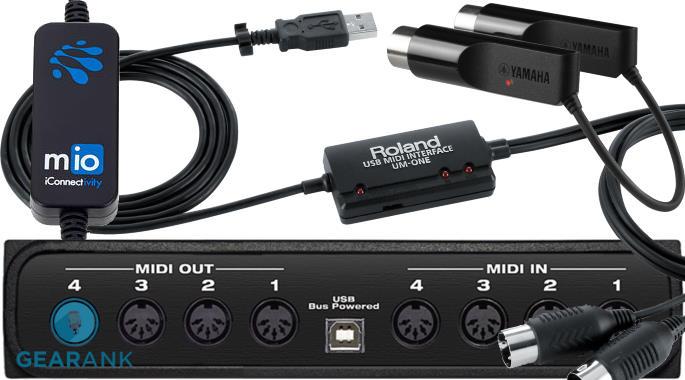
Author & Contributors
Raphael Pulgar
I've been an audio engineer for 20 years specializing in rock and metal recordings. I also play guitar and produce original music for my band and other content creators.
Wireless
Yamaha MD-BT01
Cons
- Only iOS and macOS supported
- Problem with app support for firmware updates. iOS only firmware updates via app
Pros
- Convenient wirefree experience
- Uses MIDI power
- Latency is there but not too bad
The Yamaha MD-BT01 is Bluetooth MIDI adapter that allows you to wirelessly connect to midi gear via the old school 5-Pin DIN midi connectors. So for example you can hook this up to a Yamaha DX7 and use it as a MIDI controller and a sound module. It's a pretty nifty and convenient little device and since it sips its power from the midi connection itself, there really are no wires required. Keep in mind that that some MIDI devices don't provide power and these won't work with the MB-BT01.
It's made to work with Mac and iOS devices and that's what I used for this review. Windows and Android users have been able to get it working too but its not officially supported by Yamaha and seems a little hit and miss. The adapter uses the Bluetooth Low Energy (BLE) MIDI standard which was released by Apple in 2015.
You connect the MD-BT01 to the MIDI IN and OUT of your MIDI gear. There are directional arrows to indicate which of the two connector ports connects to which but for those who've connected MIDI gear before they really don't help much since usually the MIDI IN connects to the MIDI OUT on the other side. That's not the case here as the brief 'manual' does point out so the 'in' arrow does actually go to the MIDI IN and so forth. Once your connected and switch your MIDI gear on the light should flash and you're ready to connect.
An important point to make here is that BLE MIDI is NOT the same as 'classic' Bluetooth that you would normally use for music playback. You can see some frustrated users leaving negative reviews because they didn't realize this. Yamaha don't really make this as clear as they should in their very brief instruction 'manual' either but it is there. Instead of looking to make a Bluetooth connection in the usual place you need to use the 'Audio MIDI Setup' app on macOS or on iOS you need to load up a compatible app to get the connection going. There are a lot of compatible apps in iOS including Garageband and even a dedicated third party connection app called 'midimittr' that is well regarded for connecting.

Yamaha MD-BT01 connected to a Boss SY1000 Pedal for use with the a Looper app
I connected a number of my MIDI devices with the unit and they all connected reliably and worked well. My trusty old Ensoniq SQ-80's polyphonic aftertouch flowed through perfectly to apps that can use it like Moog's Animoog Z. The weighted digital piano came through on Garageband quite smoothly and I struggled to tell whether any latency was due to unfamiliar resistance of the keys or BLE MIDI. Even a multieffects pedal worked for controlling the 'Loopy' app. It also works well for transmitting MIDI 'system exclusive' messages which is often something that can trip up MIDI adapters.
Some people have reported issues with 'jitter' - random small changes in latency. In practice I haven't experienced this as an issue and most owners don't have problems. However if you're an especially precise player or looking to use this for percussion then it could be a good idea to trial BLE MIDI before committing your entire setup to it.
Minor jitter issues aside, this is a good piece of gear that helps you reduce your cable clutter. It also helps that it is one of the most popular MIDI interfaces available.
Specifications
- Number of MIDI Ports: 1 MIDI In, 1 MIDI Out
- Compatibility: Bluetooth LE MIDI. Compatible with iOs 8 or later and Mac OSX Yosemite or later with Bluetooth 4.0 installed.
- Power Supply: Powered by MIDI Connection
- Size: 0.67"(W) x 2.63" (D) x 0.67"(H)
- Weight: 0.81oz
| Website | Source | *Rating Value |
| Gearank | Daniel Barnett | 85/100 |
| Technology in Music Education | Christopher J. Russell, Ph.D. | 90/100 |
Wired
iConnectivity mio
Cons
- iConfig software clunky to use
- 5ft cable might be too short
Pros
- Plug and Play
- No noticeable latency
- Sturdy build
- Affordable
The mio is a USB Class Compliant (plug and play) bus powered MIDI interface and a low latency and affordable option for the basic single device MIDI connections.
There's a free companion controller app called "iConfig" available for Windows, Mac and iOS that allows you to route and process MIDI in various ways as well as update the device firmware.
The plug and play class compliant interface is a great choice for future-proofing your setup.
The iConfig software is a bit complicated but is only used for more advanced features. SysEx messages may cause problems as well but that goes for many MIDI interfaces. One other thing is that the 5ft. cable might be too short.
Cons aside, the iConnectivity mio is great if you want a simple and reliable MIDI interface
Specifications
- Number of MIDI Ports: 1 MIDI In, 1 MIDI Out
- Compatibility: Class Compliant and compatible with Windows, Mac, iOS (via CCK/Lightning adaptor) and Linux
- Power Supply: USB
- Length: 5ft
- Weight: 3.5 oz
| Website | Source | *Rating Value |
| Youtube | Tayvon Gwira | 90/100 |
iConnectivity mioXC
Cons
- Does not include a manual in the package
- Cable labeling might confuse users new to MIDI
Pros
- Great compatibility and future proofing
- Works well with mobile devices
- Stable SysEX and MIDI transfers
The iConnectivity mioXC is a 1 x 1 USB-C MIDI interface that allows up to 16 channels of MIDI data to be transmitted to and from various devices. Thanks to the USB-C connection, it makes it easier to interface Hardware Synths with mobile devices running iOS or Android.
Equipped with a 32-bit ARM Cortex processor and well-engineered shielding, the mioXC provides stable data transfers for MIDI and SysEX information.
Thanks to constant driver updates and support, the mioXC runs great even on the latest (as of writing) Mac OS, Monterey. This allows it to bridge the gap between modern computer software and vintage synthesizers.
One thing that might trip up users is the lack of labelling on the MIDI IN/OUT. For veterans, this would be no problem to figure out but for those unfamiliar, the OUT cable goes into the IN port and vice versa.
Specifications
- Number of MIDI Ports: 1 MIDI In, 1 MIDI Out
- Compatibility: Class Compliant with MAC OSX, Windows XP SP2, Windows Vista, Windows 7, 8 and 10
- Power Supply: Powered by USB-C
- Size: 5.71" x 0.98" x 4.41"
- Weight: 5.9oz
Miditech MIDIFACE - 4x4
Cons
- Not the most compact form factor
Pros
- Multiple I/O enables complex setups
- Up to 64 Channels with the included MIDI cable
Miditech is a company based in Cologne, Germany and have been making music gear for over 2 decades.
The Miditech MIDIFACE is a straightforward 4 in / 4 out interface and it is class compliant. It works with MIDI devices like a keyboard controller and is compatible with most major operating systems.
Its configuration allows up to 64 channels of MIDI via the included USB Cable.
Its simplicity and class compliance means it's a great hub for even for more complex midi routing. The class compliance ensures compatibility with many operating systems. It's important to note however that in my research, I've found a few people having trouble with specific Windows 10 updates though this seems to have been resolved as of this edition of the guide.
Still, if you're looking for a MIDI interface with multiple ports, the Miditech MIDIFACE 4 x 4 is a stellar pick.
Specifications
- Number of MIDI Ports: 4 MIDI In, 4 MIDI Out
- Compatibility: Class Compliant with MAC OSX, Windows XP SP2, Windows Vista, Windows 7, 8 and 10
- Power Supply: Powered by MIDI Connection
- Size: 9.25" x 6.93" x 2.83"
- Weight: 15.5oz
Things To Consider When Buying A MIDI Interface
-
Simply put, it's a device that allows you to connect MIDI devices, such as hardware synths and keyboards that use 5-pin MIDI jacks, to your computer or tablet. The next question is What is MIDI, and the short answer is "Musical Instrument Digital Interface". It is a protocol used by musical devices to communicate with each other.
-
Some MIDI interfaces from popular brands come with "Y" cables: 2 MIDI connectors (1 In/1 Out) on one end and a USB connector. Some have multiple MIDI sockets and this is usually necessary if you want to connect multiple MIDI controller devices at the same time - an example would be connecting an Electronic Drum Set and a MIDI Keyboard to your computer. You can usually daisy chain MIDI output (receiver) devices through a single computer connection though.
There are MIDI Interfaces that are compatible with iOS devices, such as iPhones or iPads, with the use of Apple lightning cables. Any class compliant USB device can be connected to iOS devices via an Apple Camera Connection Kit or Lightning adapter - note that your iOS apps must use CoreMIDI. Part of learning How to use MIDI keyboard controllers is understanding connectivity
-
Many MIDI interfaces don't need additional AC power cables or batteries and can be powered via USB when plugged to a PC, Mac or Linux box.
Important information for iPad users: The iPad limits the amount of power available to USB devices so even though you can use Class Compliant interfaces with it you may need to use a Powered USB Hub (link to Amazon.com) to provide sufficient power. This does not apply if your MIDI interface has its own power adapter.
-
Class compliant devices are plug-and-play devices that don't need extra drivers to work (although manufacturers often supply them anyway). Although theoretically any class compliant device should work with any operating system that supports them you may have trouble with older operating systems so if you don't have the latest version of your OS then check the compatibility information carefully before purchasing (or upgrade to the latest OS if you can).
-
MIDI devices come in 3 ports: In, Out and Thru. An interface with single MIDI In and Out ports is enough to connect one MIDI controller (i.e. keyboard) to a computer and usually you can also daisy chain to other MIDI receiver units (such as sound modules) using the Thru ports in these. If you want to use multiple MIDI controllers you'll generally need multiple MIDI Input ports to your computer. Also it can be easier to control multiple MIDI receiver units with each having their own dedicated port and this can also reduce latency when there's a lot of MIDI data flying around. Another reason to have more MIDI channels is if your sound modules don't have a MIDI Thru port for daisy chaining. Each MIDI port contains 16 channels.
Most people without really complex studio setups can make do with single in/out MIDI port interfaces. But interfaces with multiple I/O ports are useful for studios with several different MIDI sources like analog synthesizers or rackmount gear with DAW-controlled MIDI switching and automation. If this is what your studio setup is like, the Miditech MIDIFACE should be worth checking out.
What is a MIDI Interface?
Connectivity
Power
Class Compliant USB MIDI
Number of MIDI Ports (Input/Output/Thru)
Best MIDI Interface Selection Methodology
The first edition was published in 2017 and the current edition was published on June 22, 2021.
We looked at all highly rated and popular MIDI interfaces available from major American music gear retailers and short-listed the 23 most promising for detailed analysis. During this procedure we processed more than 11,000 individual review and rating sources from user and expert reviews and forum comments, using the Gearank Algorithm to produce rating scores out of 100 for each interface. We then selected the highest rated options to recommend above. For more information about our methods see How Gearank Works.
About the Author and Contributors
Here are the key people and sources involved in this guide's production - click on linked names for information about their music industry backgrounds.
Lead Author & Researcher
Raphael Pulgar
I've been an audio engineer for 20 years specializing in rock and metal recordings. I also play guitar and produce original music for my band and other content creators.
I've had experience with recording MIDI instruments such as electronic drums and keyboard controllers throughout my career. And even if I have an audio interface, having a dedicated MIDI interface definitely was a good addition. Those working with USB Audio Interfaces with no MIDI capability will especially benefit. Most modern synths have USB I/O, older synths can work with modern setups with a good MIDI interface.
Contributors
Alden Acosta: Product research.
Daniel Barnett: Yamaha MD-BT01 Review.
Jason Horton: Editing and Illustrating.
Media
Main/Top Image: Created by Gearank.com using photographs of the iConnectivity mio, Roland UM-ONE mk2, Yamaha MD-BT01 and MOTU micro lite.
The individual product images were sourced from their respective manufacturers' websites, promotional materials or supporting documentation except for Yamaha MD-BT01 connected to a Boss SY1000 Pedal which was photographed by Daniel Barnett.



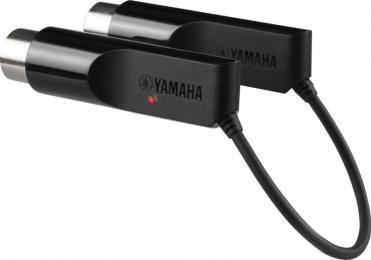
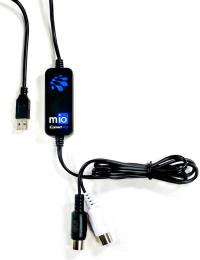
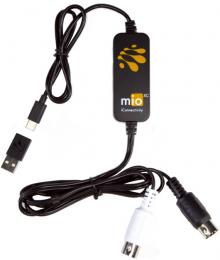
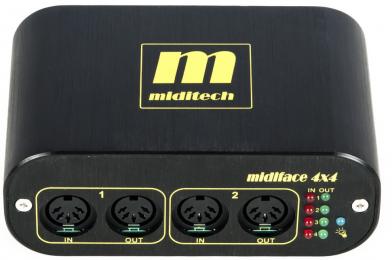
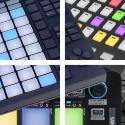
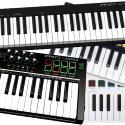
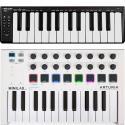
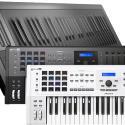
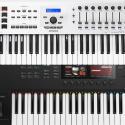
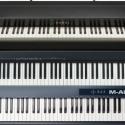

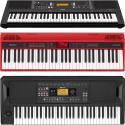

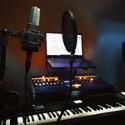
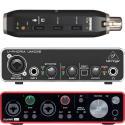

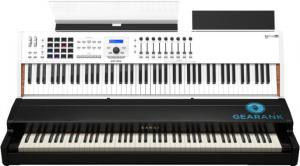
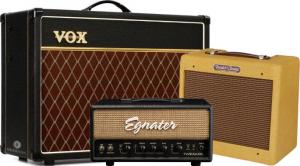
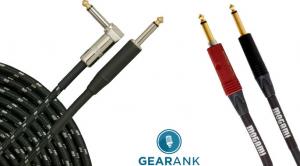

Comments
Could you add latency numbers
Submitted by Marc (not verified) on
Could you add latency numbers / measurements for these devices?
Hi Marc
Submitted by Raphael Pulgar on
Hi Marc
Unfortunately, we can't. Latency is a tricky thing to measure and present since it's also dependent on the kind of specs your computer is running. Most modern audio interfaces hover around less than 10ms even at a buffer size of 128. Dropouts are also a concern and the point where you experience stuttering can vary depending on Processor or RAM load.
-Raphael
The following MIDI interfaces
Submitted by Jason Horton on
The following MIDI interfaces came off our recommended list when we published the September 2022 Edition:
Publication of our June 2021
Submitted by Jason Horton on
Publication of our June 2021 Edition resulted in the following MIDI interface coming off the recommended list above, but you can still see our analysis of it: IK Multimedia iRig MIDI 2.
As a result of our April 2020
Submitted by Jason Horton on
As a result of our April 2020 update the following MIDI interfaces came off the recommended list above, but you can still see our analysis of them:
What was the reason why they
Submitted by Tom (not verified) on
What was the reason why they were no longer recommended? They no longer works? I bought a MidiPlus "MIDI 2x2 USB MIDI interface" running on Windows 10 and it doesn't work reliably. I'm wondering if this is related to the April 2020 Update? Would a future Windows 10 update fix this?
The MidiPlus Tbox 2X2 USB
Submitted by Jason Horton on
The MidiPlus Tbox 2X2 USB MIDI Interface was removed from our recommended list because it was no longer available to buy.
Given that it uses USB class compliant drivers it's unlikely that a simple Windows update will fix the problem. If you are having other problems with Windows then reinstalling Windows 10 *might* fix it, but I can't guarantee that it will - there could be other software causes or even malfunctioning USB hardware.
If you want tech support you could contact the manufacturer - you'll find their email address on this page of the MidiPlus website.
The following MIDI interface
Submitted by Jason Horton on
The following MIDI interface has been removed from our recommended list above due to a lack of availability: M-Audio MIDISPORT 2x2 Anniversary Edition.
As a result of a minor update
Submitted by Jason Horton on
As a result of a minor update today we have removed the following from our recommended list above: M-Audio MIDISPORT 1x1.
Great comparative study, very
Submitted by Pedro (not verified) on
Great comparative study, very clear and what I have been looking for for’quite Some time. Don’t know why I didn’t find the article earlier.
Thanks a lot for your great work.
Thank you very much for your
Submitted by Jason Horton on
Thank you very much for your appreciation of the work we do - remember to check with us first next time!